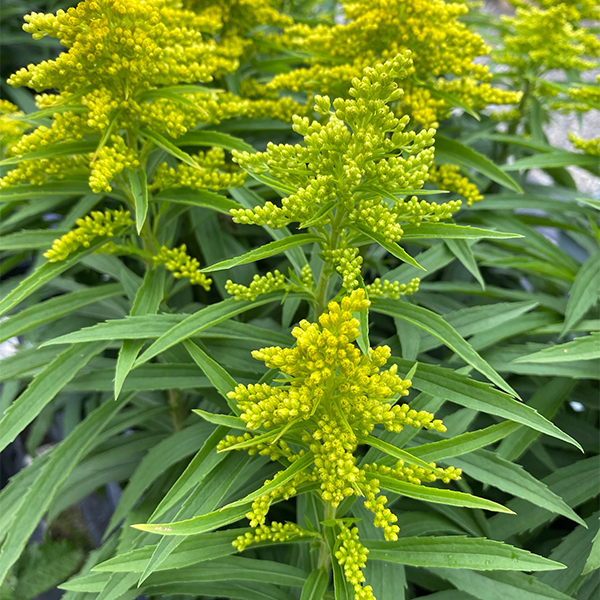By Eileen Johnson, Weston Nurseries Horticulturist
Solidagos, more commonly known as goldenrods, are native perennials seen blooming abundantly in sunny meadows in late summer. But they are plagued with an image problem. For years people with hay fever have been unjustly pointing fingers at it as the cause of their suffering. Many people use the terms goldenrod and ragweed interchangeably when in fact they are two distinct plants. Goldenrod and ragweed tend to live side by side and bloom at the same time. But ragweed, a 3-4 foot tall plant with highly dissected, lacy green leaves and inconspicuous green flowers, is barely noticeable when growing alongside a bright yellow stand of goldenrod. It is no wonder then that goldenrod is blamed for causing fall allergies. The truth is that pollen grains of goldenrod are quite large and are incapable of becoming windborn like the pollen of ragweed.
There are literally dozens of different varieties of goldenrod varying in height and flower structure, but their common trait is that they all bear yellow flowers at summer’s end. They are an important late season food source for honeybees, migrating butterflies and other nectar seeking insects so are an appropriate choice for inclusion in a butterfly garden. Because some goldenrods can be aggressive spreaders, care must be exercised when choosing a variety for use in a home garden. One of my personal favorites is a variety called ‘Fireworks’ which grows roughly 3 feet tall with 15 inch lateral sprays of golden yellow flowers radiating off of the stem in all directions, giving the plant a rather wild appearance. ‘Fireworks’ blooms in mid September, later than many of the others. Another very distinctive variety is ‘Little Lemon’, a hybrid which remains short at 12 inches. Beginning in August, ‘Little Lemon’ bears very chunky light lemony yellow flowers, a color which works in so many combinations. Try combining goldenrods with grasses for a subtle fall display, or with pink and blue asters for something more vivid. But do consider them for adding color to your fall garden.








